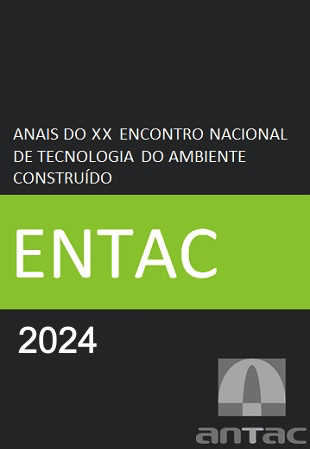Influência da ventilação natural no conforto térmico de ocupantes em edificações com coberturas frias e verdes
DOI:
https://doi.org/10.46421/entac.v20i1.5694Palavras-chave:
Conforto térmico, Edificação residencial, Cobertura verde, Cobertura fria, Simulação computacionalResumo
A utilização de ventilação natural é comum em edificações residenciais brasileiras, seja por questões culturais ou pela inexistência de aparelhos de ar-condicionado. Este estudo tem como objetivo investigar a influência da configuração de ventilação natural no conforto térmico dos ocupantes em edificações com cobertura convencional, fria e verde. Três configurações foram avaliadas no clima de Florianópolis/SC: ventilação durante os períodos de ocupação, ventilação de manhã à noite e ventilação noturna nos ambientes de permanência prolongada. O percentual de horas de conforto térmico foi calculado por meio de variáveis obtidas a partir de simulação computacional no programa EnergyPlus. Os resultados mostraram que a configuração de ventilação que proporcionou o maior percentual de horas de conforto no ano variou conforme o ambiente analisado, principalmente devido ao período de ocupação. Independentemente da configuração de ventilação natural, a cobertura verde foi a que proporcionou o maior percentual de horas de conforto. Dessa forma, o estudo contribui com o entendimento da influência dos padrões de uso da ventilação natural em edificações com diferentes tipos de cobertura.
Referências
RAMOS, G et al. Adaptive behaviour and air conditioning use in Brazilian residential buildings. Building Research & Information, v.49, n. 5, p. 496-511, 2021. DOI: https://doi.org/10.1080/09613218.2020.1804314.
SORGATO, M.J.; MELO, A.P.; LAMBERTS, R. The effect of window opening ventilation control on residential building energy consumption. Energy and Buildings, v. 133, p. 1-13, 2016. DOI: https://doi.org/10.1016/j.enbuild.2016.09.059.
PISELLI, C.; SAFFARI, M.; GRACIA, A.; PISELLO, A.L.; COTANA, F.; CABEZA, L.F. Optimization of roof solar reflectance under different climate conditions, occupancy, building configuration and energy systems. Energy and Buildings, v. 151, p. 81-97, 2017. DOI: https://doi.org/10.1016/j.enbuild.2017.06.045.
TEIXEIRA, P.S. Análise da eficiência termoenergética de sistemas de coberturas para o clima subtropical úmido de edificações residenciais em Foz do Iguaçu. 2022. Dissertação (Mestrado em Engenharia Civil) – Universidade Federal da Integração Latino-Americana, Foz do Iguaçu, 2022.
SYNNEFA, A.; SANTAMOURIS, M.; AKBARI, H. Estimating the effect of using cool coatings on energy loads and thermal comfort in residential buildings in various climatic conditions. Energy and Buildings, v. 39, n. 11, p. 1167–1174, 2007. DOI: https://doi.org/10.1016/j.enbuild.2007.01.004.
GAGLIANO, A.; DETOMMASO, M.; NOCERA, F.; EVOLA, G. A multi-criteria methodology for comparing the energy and environmental behavior of cool, green and traditional roofs. Building and Environment, v. 90, p. 71-81, 2015. DOI: https://doi.org/10.1016/j.buildenv.2015.02.043.
CIRRINCIONE, L.; MARVUGLIA, A.; SCACCIANOCE, G. Assessing the effectiveness of green roofs in enhancing the energy and indoor comfort resilience of urban buildings to climate change: Methodology proposal and application. Building and Environment, v. 205, p. 108198, 2021. DOI: https://doi.org/10.1016/j.buildenv.2021.108198.
BEVILACQUA, P. The effectiveness of green roofs in reducing building energy consumptions across different climates. A summary of literature results. Renewable and Sustainable Energy Reviews, v. 151, p. 111523, 2021. DOI: https://doi:10.1016/J.RSER.2021.111523.
SANTAMOURIS, M.; SYNNEFA, A.; KARLESSI, T. Using advanced cool materials in the urban built environment to mitigate heat islands and improve thermal comfort conditions. Solar energy, v. 85, n. 12, p. 3085-3102, 2011. DOI: https://doi.org/10.1016/j.solener.2010.12.023.
RUPP, R.F.; KIM, J.; DEAR, R.; GHISI, E. Associations of occupant demographics, thermal history and obesity variables with their thermal comfort in air-conditioned and mixed-mode ventilation office buildings. Building and Environment, v. 135, 2018. DOI: https://doi.org/10.1016/j.buildenv.2018.02.049.
GUO, R.; GAO, Y.; ZHUANG, C.; HEISELBERG, P.; LEVINSON, R.; ZHAO, X.; SHI, D. Optimization of cool roof and night ventilation in office buildings: A case study in Xiamen, China. Renewable Energy, v. 147, p. 2279-2294, 2020. https://doi.org/10.1016/j.renene.2019.10.032.
GAGLIANO, A.; DETOMMASO, M.; NOCERA, F.; BERARDI, U. The adoption of green roofs for the retrofitting of existing buildings in the Mediterranean climate. International Journal of Sustainable Building Technology and Urban Development, v. 7, p. 116-129, 2016. DOI: https://doi.org/10.1080/2093761X.2016.1172279.
CRAWLEY, D.; LAWRIE, L. Repository of free climate data for building performance simulation: Brazil, Region 3 - South America. 2021. Disponível em: https://climate.onebuilding.org/WMO_Region_3_South_America/BRA_Brazil/index.htm. Acesso em: 24 de julho 2023.
ALVARES, C.A.; STAPE, J.L.; SENTELHAS, P.C.; GONÇALVES, J.L.M.; SPAROVEK, G. Köppen’s climate classification map for Brazil. Meteorologische Zeitschrift, v. 22, n. 6, p. 711-728, 2013. DOI: https://doi.org/10.1127/0941-2948/2013/0507.
TRIANA, M.A.; LAMBERTS, R.; SASSI, P. Characterisation of representative building typologies for social housing projects in Brazil and its energy performance. Energy Policy, v. 87, p. 524-541, 2015. DOI: https://doi.org/10.1016/j.enpol.2015.08.041.
PISELLO, A.L.; PISELLI, C.; COTANA, F. Influence of human behavior on cool roof effect for summer cooling. Building and Environment, v. 88, 116-128, 2015. DOI: https://doi.org/10.1016/j.buildenv.2014.09.025.
CASCONE, S.; CATANIA, F.; GAGLIANO, G.; SCIUTO, G. A comprehensive study on green roof performance for retrofitting existing buildings. Building and Environment, v. 136, p. 227-239, 2018. DOI: https://doi.org/10.1016/j.buildenv.2018.03.052.
ASSOCIAÇÃO BRASILEIRA DE NORMAS TÉCNICAS. NBR 15575-1: Edificações habitacionais - Desempenho. Parte 1: Requisitos gerais. Rio de Janeiro, 2021.
ASSOCIAÇÃO BRASILEIRA DE NORMAS TÉCNICAS. NBR 15520-2: Desempenho térmico de edificações. Parte 2: Métodos de cálculo da transmitância térmica, da capacidade térmica, do atraso térmico e do fator solar de elementos e componentes de edificações, Rio de Janeiro, 2003.
ZIOGOU, I.; MICHOPOULOS, A.; VOULGARI, V.; ZACHARIADIS, T. Energy, environmental and economic assessment of electricity savings from the operation of green roofs in urban office buildings of a warm Mediterranean region. Journal of Cleaner Production, v. 168 p. 346-356, 2017. https://doi.org/10.1016/j.jclepro.2017.08.217.
SHI, D.; GAO, Y.; GUO, R.; LEVINSON, R.; SUN, Z.; LI, B. Life cycle assessment of white roof and sedum-tray garden roof for office buildings in China. Sustainable Cities and Society, v. 46, p. 101390, 2019. DOI: https://doi.org/10.1016/j.scs.2018.12.018.
ASSOCIAÇÃO BRASILEIRA DE NORMAS TÉCNICAS. NBR ISO 10456: Materiais e produtos de construção - Propriedades higrotérmicas - Valores e procedimentos de projeto tabulados para determinar valores térmicos declarados e de projeto, Rio de Janeiro, 2022.
KOROXENIDIS, E.; THEODOSIOU, T. Comparative environmental and economic evaluation of green roofs under Mediterranean climate conditions – Extensive green roofs a potentially preferable solution. Journal of Cleaner Production, v. 311, p. 127563, 2021. DOI: https://doi:10.1016/J.JCLEPRO.2021.127563.
AMERICAN SOCIETY OF HEATING, REFRIGERATING AND AIR-CONDITIONING ENGINEERS. ASHRAE 55: Thermal Environmental Conditions for Human Occupancy, Atlanta, 2020.

